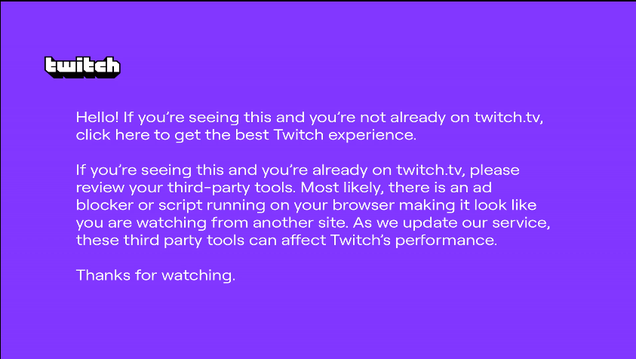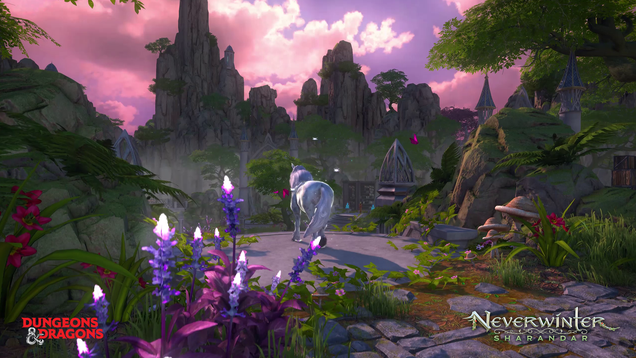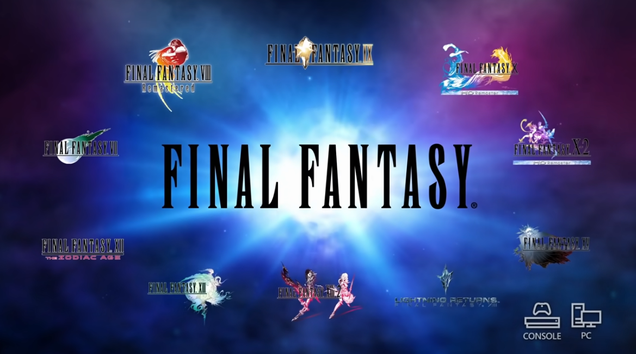In the past couple months, the experience of watching Twitch via third-party sites or tools like MultiTwitch has become... fraught. A purple screen sometimes obscures whatever you’re watching. It implores you to tune in on Twitch dot television instead. Eventually, it disappears. Then, every 15 minutes or so, it comes back. As of a couple days ago, it has a partner in crime.
As outlined on Twitter by Ben “FishStix” Goldhaber, former Twitch founding team member and current CEO of esports site Juked, Twitch now bombards embed viewers with a pop-up that tells them to “get the full [insert channel name here] experience” on Twitch. Unlike the purple screen of death, which comes and goes as it pleases, you can at least banish this one by clicking on a little X, but it still obscures a large chunk of the video until you do. On its developer site, Twitch said that, for now, this pop-up is a “temporary experiment.” It went on to say that the goal of such experiments is to “assess the impact that embeds have on discovery and audience growth for creators” and to ultimately learn how to deliver “better info to viewers, more long-term audience/revenue value to creators, and more insight to developers utilizing embeds.”
Taken together, however, the message underlying these embed obstacles is irritatingly obvious: Twitch wants viewers to congregate on its website—not elsewhere—even though they are doing so using functionality that Twitch itself built. Moreover, as Goldhaber pointed out on Twitter, there are clear upsides to a friction-free stream embed experience.
“Streamers, viewers, and Twitch do benefit from embed,” he wrote. “Views count towards their metric, embeds allow for users to subscribe and follow a channel directly. Developers are creating new experiences around the Twitch player, and facilitating discovery for new communities.”
Now, of course, Goldhaber would say this, given that Twitch embeds are a pillar of his site, Juked, which embeds esports streams and provides additional resources for viewers. But he told Kotaku that embeds have historically functioned as a cornerstone of Twitch’s business, as well. He would know. He says he worked on them during Twitch’s earliest days—long before it had become the de facto video game streaming site, or even its parent company’s main focus.
“The idea to focus on gaming and ultimately launch Twitch came in large part from interest in StarCraft 2 streams, which were blowing up at the time. Why? Because of TeamLiquid.net,” Goldhaber told Kotaku in an email. “TL was the largest community site for StarCraft fans in the West, and very early on built a stream directory which aggregated SC2 beta streams and tournaments onto an easy-to-use sidebar... Tech companies are always looking for growth hacks, and the embed player was exactly that for us. Just copy/paste this HTML on your website and boom, a Twitch player. Team Liquid was just one of many community hubs that utilized the Twitch player in this way.”
But times have changed. Thanks to ads, promotions, algorithms, and a variety of other mechanisms that allow Twitch to both tailor and control what viewers experience, it has every reason to corral viewers into its ecosystem. This hurts the sorts of smaller, third-party creators that helped Twitch evolve into the behemoth it is today, but this is simply the way of tech giants: they feed on communities until they grow large enough to assimilate them. Then they actively work to ensure that they remain the only game in town. It feels like beating a dead horse to say this, but there’s a reason most modern internet users rarely visit websites outside of a small handful of Facebook, Google, Twitter, and Amazon-owned pages and apps. That’s the most profitable model. Tech giants know it. This is how it happens.
“It feels like Twitch has changed their tone from ‘growth at all costs’ to ‘monetization at all costs,’” said Goldhaber. “The recent changes to hamstring embeds are being touted as ‘experiments’ to see how people engage with embeds, but you can’t look at these and not see them as directly harming third party developers and communities that have developed around the Twitch API.”
In response to Kotaku’s questions about the goals of recent embed changes, a Twitch spokesperson sent over a statement. “We constantly tweak our ad delivery system, including a recent update that shows a screen on embed streams that recommends twitch.tv,” the spokesperson said in an email. “We will continue to adjust this experience based on user feedback.”
Twitch still has profound discoverability issues that are partially remedied by embeds on other sites. As examples, Goldhaber offered OutdoorIRL, a collaborative effort to aid outdoors streamers, as well as his site, Juked. Others have pointed to charity-focused sites like Tiltify as potential victims of these new initiatives. But Twitch is addressing discoverability at its own pace with clips (which come with a slew of their own issues, like harassment) and a rudimentary recommendation system, among other features. For now, it seems set on that course, flawed though it might be.
Embeds have also caused problems; in recent years, wikis and other organizations have taken to embedding streams on highly trafficked pages in order to artificially inflate viewer counts, which has cascading impacts on everything from Twitch directory positioning to business deals. Twitch itself has even employed these sorts of strategies when advertising on sites like Reddit, sometimes to the discomfort of streamers whose broadcasts it has embedded. The resulting viewers are not “real”—most are likely scrolling past without noticing the stream—but they nonetheless count as viewers.
It’s obviously pretty shady, but Goldhaber doesn’t think Twitch’s recent embed changes have much to do with curtailing this practice.
“Embeds have been used in shady ways since time immemorial (embedded in a 1x1 pixel or in banner ads on a highly trafficked wiki, etc),” he said. “But my take is that these recent changes have nothing to do with bad actors utilizing the embed to juice viewership, and everything to do with Twitch’s aggressive advertising goals.”
Goldhaber wishes Twitch would work with the sorts of third-party communities that helped first give rise to the platform, rather than against them.
“Twitch removed advertising from embeds about 2 years ago for various reasons, but I think I speak for everyone who uses the Twitch API/embed player when I say we’d be happy to show your ads,” he said. “Let us opt-in! Just don’t screw over the developers and communities who use your API for wholesome, legitimate reasons... [Juked’s] goal is to help elevate all esports games/communities. That should be aligned with Twitch’s goals—and would be, if Twitch was still the same company I joined back in 2011.”
Source: kotaku










